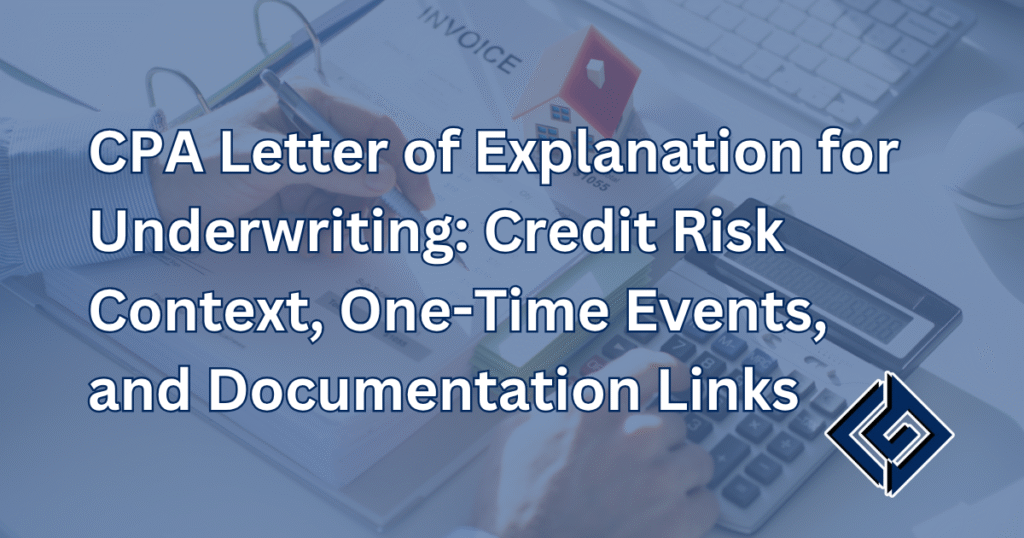A cpa letter of explanation gives underwriters context they can file fast.
It explains one-time events. It links numbers to records. It keeps scope tight and professional.
What a CPA Letter of Explanation Covers
A Certified Public Accountant prepares a short, signed letter on firm letterhead.
It adds clarity without turning the engagement into an audit.
Core items the letter addresses
- The borrower’s situation in plain language.
- The period affected and the dollar impact on income or cash flow.
- The records used: tax return, financial statements, and account history.
- Linkouts or references to documents the lenders already have.
- Limits of the procedures and a statement that no opinion or assurance is expressed.
What it is not
- Not an audit, auditing review, or audit reports.
- Not legal advice.
- Not a guarantee of loans or rates.
When Lenders and Landlords Request It
Underwriting asks for a letter when something looks unusual.
Common triggers in mortgage and refinance files
- Year-over-year income shifts for self-employment or sole proprietor returns.
- Business ownership changes in a limited liability company.
- Large deposits tied to assets or down payment.
- Short employment gaps for W-2 earners.
Rental screening
Landlords may request a letter to explain variable revenue or recent business changes.
The same format works for rent files with minor edits.
Standards and Boundaries
CPAs follow the American Institute of Certified Public Accountants framework.
That keeps wording usable and defensible.
AICPA-aligned limits
- The letter describes procedures and records.
- It does not provide assurance on internal controls or future cash flows.
- It does not replace lender verification steps.
Why these limits matter
They protect the borrower, the money lender, and the firm’s professional liability position.
They also help investor reviews of the mortgage loan file.
Records to Have Ready
Short list. Clean copies speed decisions.
For self-employment
- Most recent tax return with all schedules.
- YTD financial statements: P&L and balance sheet.
- Bank history that shows deposits tied to sales.
For W-2 earners
- Recent pay stubs.
- Employer confirmation if lending requires verification.
- Prior-year tax forms for reference.
For assets and down payment
- Account statements.
- Source notes for gifts or transfers.
- Any settlement documents that explain timing.
Letter of Explanation Template
Subject: CPA Letter of Explanation — [Borrower Name], [Loan #]
I am a CPA for [Client/Company]. For the period [dates], I reviewed filed tax returns, current management financial statements, and selected account activity.
Context: [Describe the one-time event or variance]
Impact: The effect on income (or cash) for [period] was approximately $[amount].
Documentation links: [Identify where the underwriter can find the schedules or statements already in the file].
Procedures were limited to comparisons and tie-outs. This is not an audit, review, or assurance report under AICPA standards
Signed,
[Name], Certified Public Accountant — [Firm], License [State]
Scenarios the Letter Explains Well
Self-employment swing
A contract ended mid-year. New contract started the next quarter.
The letter compares quarters and ties deposits to invoices.
Result: the home loan worksheet uses normalized income.
LLC ownership change
A partner exited. Distributions spiked for one month.
The letter cites the buyout agreement and shows the non-recurring cash flow.
One-time medical event
A short gap in W-2 wages.
The letter notes dates and re-employment, with pay stubs attached elsewhere in the file.
Asset sale used for down payment
Proceeds hit the account as a large deposit.
The letter references the bill of sale and closing statement already uploaded.
How Underwriters Use the Letter
They place the letter behind the relevant condition.
They match the narrative to the numbers and move on.
- Reduces email loops and rework.
- Improves perceived accuracy and credibility.
- Fits cleanly in mortgage and refinance documentation stacks.
Where CPA Letter Services Fit
CPA letter services package these deliverables to match lender checklists.
You get clear scope, timeline, and secure delivery.
Deliverables
- A concise letter in PDF.
- Optional addendum pointing to the exact schedules.
- Secure submission to the portal or contact listed.
Why a CPA (not just “an accountant”)?
Licensing, training, and ethics rules under certified public accounting.
Alignment with AICPA guidance and state boards.
Better acceptance with lenders and secondary review teams.
Keeping It Inside Accounting
The letter sits in accounting territory.
It avoids assurance language while still helping the reader.
Allowable procedures
- Compare P&L totals to deposits.
- Tie annual figures to filed IRS schedules.
- Recalculate a simple ratio when requested.
What we do not say
- No blanket opinion on the business or the borrower.
- No statements about future performance.
- No coverage of internal controls beyond the narrative.
